What is Alopecia Areata?
Alopecia areata is a disease where hairless patches develop on the scalp or any hairy part of the skin. It is a chronic, recurring, and autoimmune disorder. Autoimmune disease is a condition where the body attacks its own immune system. One or more bald spots occur commonly on the scalp, but this condition can also affect other hairy areas of the body, such as eyebrows, eyelashes, face (beard area), private parts, and other body areas.
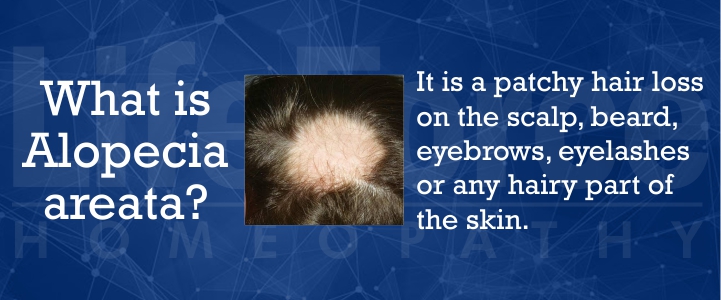
The term ‘alopecia’ is derived from a Latin word that means baldness, and the word ‘areata’ refers to patchy hair loss, a typical symptom of this disease.
Alopecia areata affects people of any age, but it is most commonly noted in early childhood and adulthood. It is not a painful or disabling condition, but it may profoundly affect one’s personality, making it a cause for embarrassment.
Homeopathic Treatment For Alopecia Areata
- Homeopathy offers an excellent treatment for alopecia areata, particularly for early-detected cases and mild to moderate cases.
- Alopecia areata is an internal disease that needs to be treated through internal immune correction, which is possible with homeopathy.
- Homeopathy is safe and highly effective in most cases of alopecia
- Previous use of corticosteroids may slow down the results with homeopathic treatment.
- Homeopathic medicines, such as Phosphorus, Natrum muriaticum, Fluoric acid, Phosphoric acid, Lycopodium, Vinca minor, and others, can trigger the body’s immune system to fight back the disease effectively. There are over 40-50 possible drugs to select to treat alopecia areata. It is not advisable to take these medicines without a prescription.
- These remedies could bring the deranged immunity back to normal.
- The exact medicine must be selected based on individual case evaluations.

Scope Of Improvement Using Homeopathy:
- Mild to moderate cases of alopecia areata can be treated effectively with homeopathy. Timely diagnosis is the key to a good recovery.
- Cases that are detected early and which are not complicated with any other autoimmune disease have a good scope for recovery.
- Non-scarring alopecia has a wider scope of treatment compared to scarred alopecia.
- Individuals with large and widespread bald patches (severe alopecia- grade 3) have less scope of recovery. Such cases could be irreversible and their further spread can be controlled to some extent.
- Children suffering from alopecia have a much better scope of recovery than adults.
- Homeopathic treatment offers long-term relief compared to any other form of treatment.
- It reduces the chances of relapse significantly in promptly detected cases of alopecia. It is important to know that there are significantly fewer chances of recovery with homeopathy when it comes to the other types of alopecia i.e. alopecia totalis and alopecia Universalis.
Duration Of Homeopathic Treatment:
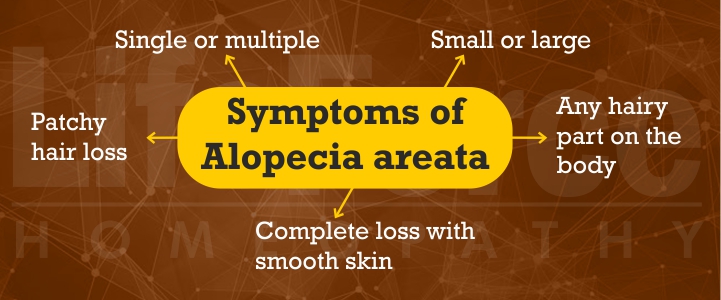
- The duration of homeopathic treatment completely depends on the type of alopecia and the duration of alopecia (i.e. since when the individual is suffering from it).
- Early detection and prompt treatment reduce the duration of the treatment significantly. If the disease is progressive (advanced alopecia), the time taken for recovery is more.
- Individuals suffering from mild to moderate alopecia (small to moderate-sized bald patches) take less time for recovery compared to people having large patches.
- Individuals having one or more associated autoimmune diseases definitely need long-term treatment than those who do not have any other associated disease.
- Approximately four months to two years may be required depending on the size and the number of spots, underlying causative factors, and previous treatment.
- It is not possible to grow hair on scarred alopecia areata (such as Lichen planopilaris) or Alopecia totalis.
- There could be individual variations. Some cases may respond fast, while some may respond slowly.
Our Experience In Treating Alopecia Areata At Life Force
Based on our rich experience of 33 years at Life Force Homeopathy, we have been treating over a thousand cases of alopecia areata. We have treated different varieties of alopecia areata in people of all ages and various constitutions. Out of these, we have observed and documented successful results in children and adults suffering from this autoimmune disease. It is important to know that a few extensive cases of alopecia areata can be offered supportive treatment through our medicines. We clearly explain the scope of homeopathy to the patients in the respective cases of alopecia. Through the online treatment model, we can reach many people across the globe who wish to take benefit of homeopathy for alopecia. By using modern homeopathic medicines, we have observed a significant recovery in most cases of alopecia areata.

Based on our extensive experience, we strongly recommend homeopathy for the treatment of alopecia areata.
Pathogenesis:
Normally, the immune system is known to protect the body from bacteria and viruses. It is a shield that prevents them from entering the body. In autoimmune disorders like alopecia, there is a dysfunction in the immune system, failing to recognize the body’s own tissues. In alopecia areata, the immune system mistakenly attacks the hair follicles (a structure from which the hair grows), resulting in circular coin-sized bald patches, which may increase in size and number over time. However, the exact cause of what triggers the immune system to cause hair loss is still unknown. Microscopically, it has been observed that the hair follicles (hair roots) are attacked by lymphocytes (immune cells) during the anagen (hair growing) phase, thereby resulting in hair loss.

Alopecia areata affects individuals who are genetically predisposed to develop this condition. This hair loss can be spontaneously seen anywhere on the body. It can also be a gradual phenomenon, where hair loss goes unnoticed initially. It is often mistaken for hair thinning or female pattern or male pattern baldness in the initial stages. Alopecia areata is a condition wherein many individuals go into remission (a symptom-free period), and symptoms recur again after a few years. It is often seen that people suffering from alopecia areata have a family history of other autoimmune diseases, such as diabetes, underactive thyroid (hypothyroidism), and rheumatoid arthritis, which make them prone to contracting this disease.
Prevalence:
Alopecia areata affects nearly 2% of the population in India. Males and females are equally affected by this condition.
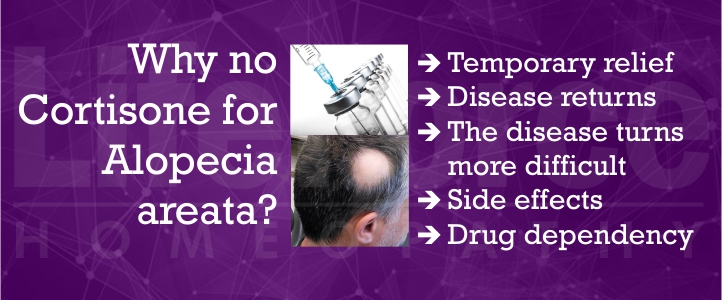
Causes Of Alopecia Areata:
- Genetic Factors: Many genes have been linked with alopecia areata that participate in the body’s immune response. The genes belonging to HLA (Human leukocyte antigen) are responsible for modifying the immune response and targeting the hair follicles. It is often seen that individuals suffering from this disorder have some other autoimmune disorder, unlike alopecia areata running in their families.
- Chemicals: Regular and long-term use of cosmetics, such as shampoos, conditions, and serums that are sulfur, ether, and paraben-based, damage the hair follicles, thereby provoking hair fall and, later, alopecia if not controlled within time.
- Mechanical: Tying the hair tightly for a long time causes the hairline to recede back, leading to traction alopecia.
- Hormonal Factors: Alopecia is linked with certain hormonal fluctuations. It has been observed that a few cases of alopecia occur during various stages of life where the hormones have an active role to play. Alopecia areata is found to be triggered during puberty, menopause, and after delivery.
- Trichotillomania: It is a psychological disorder where a person is compelled to pull out his/her own hair on the scalp, eyebrows, eyelashes, and other hairy areas of the body.
- Fungal Infection: Conditions affecting the scalp, such as seborrheic dermatitis and tinea capitis, can also lead to patchy hair loss in the diseased area. This is a reversible condition since hair grows back once the underlying fungal infection affecting the hair follicles is treated.
- Associated Disease Condition: Individuals suffering from other autoimmune skin diseases, such as psoriasis, atopic dermatitis (eczema), and lichen planus, are prone to develop alopecia areata. For instance, a person having psoriasis of the scalp has scaling and itchy skin, which leads to hair loss, thereby causing bald patches in the affected area. A similar presentation is seen in the other two skin disorders. When baldness occurs as a result of these underlying conditions, this type of alopecia areata is called scarred alopecia. In this particular condition, the hair does not grow back due to a permanent scar formation over the hair follicles. This scar destroys the hair follicles, thereby causing permanent balding in that area.

Types Of Alopecia Areata:
- Alopecia Totalis: In this variety, there is a loss of hair over the whole scalp
- Alopecia Universalis: In alopecia Universalis, complete hair loss occurs all over the body, including the scalp, eyebrows, eyelashes, beard, armpits, and private parts.
- Traction Alopecia: Baldness is caused due to the constant mechanical pulling of the hair. This is a reversible condition if treated early, but it may become irreversible in the later stages.
Symptoms Of Alopecia Areata:
- Hair Loss: The major symptom of alopecia areata is patchy hair loss. Hair falls out, leading to the formation of circular bald patches in the affected area.
- PinPoint Hair: This type of hair growth may be seen at the margin of the bald patches resembling an exclamation mark.
- Irritation: Some patients may complain of pain and itching in the bald spot, though this might be insignificant.
- Scarring: Areas of hyperpigmentation (dark discoloration) in the bald spots can be seen in individuals suffering from scarred alopecia areata.
- Pitted Nails: On examining the nails, they may be pitted white or yellow.
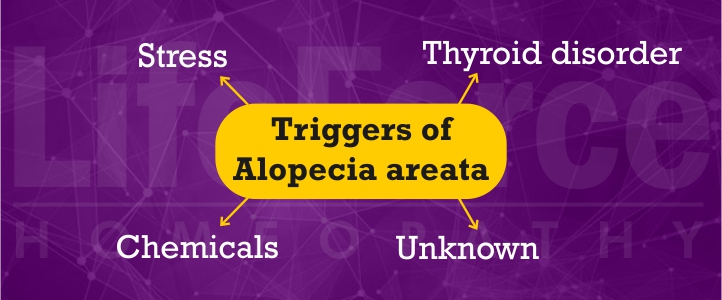
Diagnosis Of Alopecia Areata:
The key to diagnosing alopecia areata is observing the circular bald patches on the scalp, which are characteristic of alopecia areata. On examination, the bald patches are smooth in texture. Diagnosis can also be confirmed through trichoscopy, which shows yellow and black dots (destroyed hair at the follicles). Blood tests, such as thyroid function tests, blood sugar levels, C reactive protein, iron levels, and others, might be performed to rule out any other autoimmune disease.
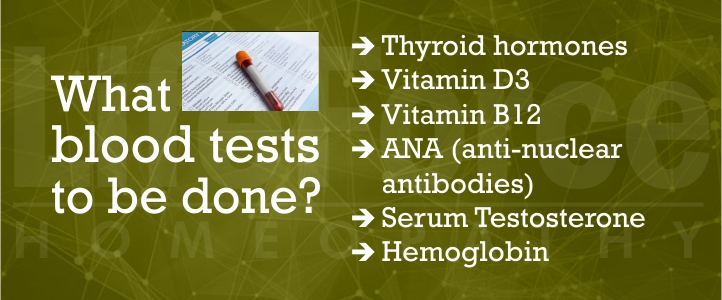
Conventional Treatment
- Ointments: Topical corticosteroids (immunosuppressants), such as clobetasol, can be applied locally on bald patches. Lotions, such as Minoxidil and Finasteride, top dermatologists' prescriptions, which have shown a fair amount of hair regrowth. But, once the usage is stopped, the hair growth stops, and the hair that had grown also falls off. This phenomenon is known as the steroid withdrawal effect.
- Injections: Corticosteroid injections are commonly used on bald patches. The treatment has to be continued for a long time, once every 1-2 months, to gain sustained relief.
- Oral Immunosuppressants: Drugs, such as methotrexate and cyclosporine, are administered in cases of moderate to severe alopecia. These drugs work by blocking the body’s immune response. They are effective but cannot be continued for a long time due to their side effects, such as liver and kidney damage and hypertension (high blood pressure).
- Hair Transplants: Permanent hair loss or severe alopecia is treated with this treatment. It is also known as skin grafting, where a few hairs are taken from behind the head and replaced in the bald area.

Four Supportive Measures To Follow To Treat Alopecia Areata
Along with the medical treatment for alopecia areata, diet and good care of the scalp help in accelerating the recovery. Following a few home remedies along with a diet specific for treating alopecia will go a long way in sustaining recovery from this disorder.
- Natural Oils: Oils, such as virgin (cold pressed) coconut oil, castor oil, jojoba oil, and rosemary oils, are age-old panaceas for promoting hair growth. The real potential of coconut oil is the presence of lauric acid, which when used topically, helps to restore hair growth. It also has anti-inflammatory properties, which help in healing underlying diseases, such as psoriasis, and it helps moisturize the skin to combat dryness.
- Onion Juice: Many people have experienced some sort of hair regrowth after rubbing onion juice on their scalp, though hair regrowth in alopecia has not been proven yet.
- Scalp Protection: Avoid using any chemical-based shampoos. Opt for sulfate and paraben-free shampoos to wash your hair. Prevent bald spots from getting exposed to the sun. Carry a hat or wear a scarf before stepping out in the sun.
- Diet: Since it is found that alopecia results from iron deficiency and lack of proteins (hair is made up of a protein called keratin), I prefer to consume a diet rich in protein and iron. Include foods, such as jaggery, dates, chana, egg whites, broccoli, and fruits like watermelon, and apple, in your diet. Vitamin C acts as a mediator in iron absorption, so include foods such as gooseberry (amla), oranges, guava, kiwis, and berries in your diet. This might promote hair regrowth to some extent.
Related Disease
- Male/ Female Pattern Baldness
- Alopecia Totalis/ Universalis
- Tinea Capitis
- Traction Alopecia
- Telogen Effluvium
- Discoid Lupus Erythematosus
- SLE (Systemic Lupus)
- Trichotillomania